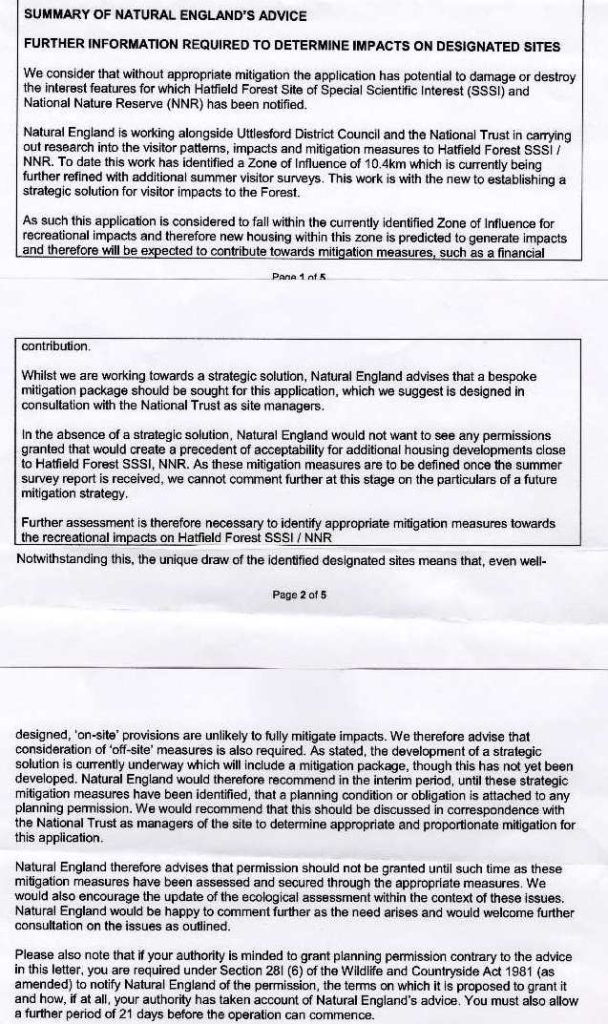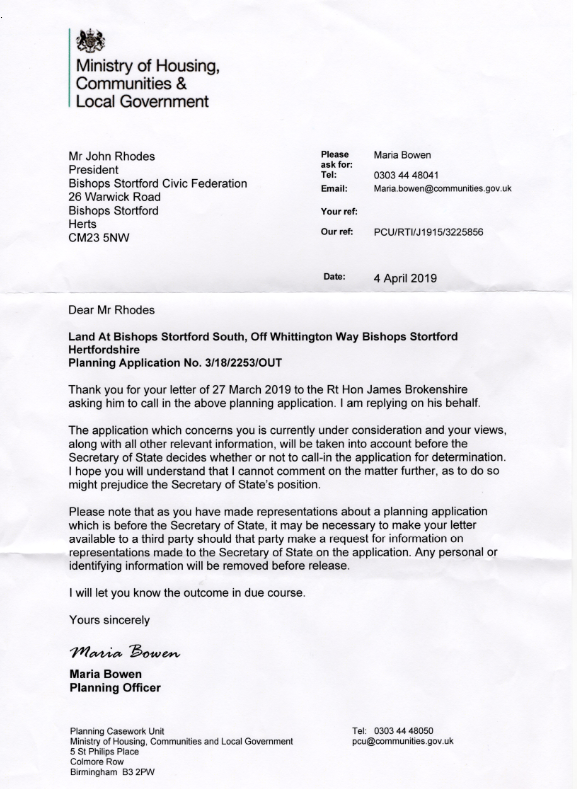Rt Hon James Brokenshire MP
Secretary of State for Housing, Communities and Local Government
Fry Building
2 Marsham Street
London
SW1P 4DF 27 March 2019
Dear Secretary of State
BISHOP’S STORTFORD SOUTH
EAST HERTS PLANNING REFERENCE: 3/18/2253/OUT
1. I am writing on behalf of the Bishop’s Stortford Civic Federation to request that you call in the above planning application for your own determination under the powers conferred on you by Section 77 of the Town And Country Planning Act 1990. I appreciate that you do not normally consider the exercise of these powers prior to the Local Planning Authority (LPA) expressing its view about an application. In this case, the Development Management Committee of East Herts District Council (EHDC) resolved at its meeting on 20 March 2019 to grant permission subject to conditions. These conditions and the accompanying S106 agreement have not yet been finalised, and so we would ask that you issue a holding direction to EHDC instructing them not to conclude these matters or issue a decision notice until you have had a chance to consider this request.
2. Proposals for the development of the site have been around for more than a decade and have always been controversial. The site was added to the Metropolitan Green Belt as recently as 1979. A proposal to release part of it for educational purposes was considered and rejected by the Inspector holding the Examination in Public prior to the adoption of the 2007 Local Plan for the District. The school sponsors nevertheless lodged a planning application to develop part of the site. This was refused by EHDC in 2010 and went to appeal. The appeal was recommended for refusal in 2011 and your predecessor, Mr Pickles, confirmed the Inspector’s recommendation in 2012.
3. As part of the preparation of the recently adopted District Plan, EHDC commissioned an independent review of all the Green Belt sites within the District which concluded that this site fell within the second least suitable category for development. EHDC nevertheless included its release from the Green Belt for development in the draft District Plan in the teeth of widespread and strongly expressed opposition from the town’s residents. At the Examination in Public preceding the adoption of the District Plan last year, the Inspector conceded that very special circumstances had to be identified to justify, not merely the principle of Green Belt release for housing development, but whether they applied to each individual site. She concluded that the ‘objectively assessed’ need for housing for the District was a sufficient justification for the release of this site.
4. In doing so, however, she ignored all the previous planning history affecting the site, the large number of dwellings allocated to Bishop’s Stortford under the Plan – over 25% of the total for the whole of the District, and the first edition of the National Planning Policy Framework (NPPF) whose criteria for Green Belt boundary changes were the ones which should have informed her consideration of the release of this site. She did not identify any very special circumstances which had emerged since partial development was refused permission in 2012. The adopted District Plan has not confirmed the new Green Belt boundaries consequent upon the release of this site, nor has it identified any new area for Green Belt protection to compensate for that which would be lost. Since the completion of her report the ONS has produced new household formation forecasts which, for East Herts, project a figure 14% lower than those on which the adopted District Plan was based – equivalent to some 2500 fewer dwellings. The release of this site for development is therefore no longer required to meet East Herts’ housing need.
5. We wrote to you on 19 August 2018, asking you to call in the District Plan for your own consideration before EHDC adopted it because of the misapplication of Green Belt policy. You issued a holding direction to EHDC on 11 September. On 12 October you wrote to the Council (not copied to any of the parties who had requested your intervention) lifting the direction and the Council then proceeded to adopt the Plan on 23 October. The site which is the subject of this letter thus forms part of the adopted District Plan as a site for housing and mixed use development. Your decision letter did not address any of the specific concerns raised with you in my letter of 19 August.
6. In any event, this should not mean that the site should be considered suitable for any development the applicant chooses to put forward. In this case we believe that the application, and the LPA’s consideration of it, raise serious issues of more than local consequence which merit your intervention. Looking at the ‘Caborn principles’, in our view the application conflicts with Green Belt policy for the reasons set out above, and thus conflicts with national policies on important matters. This alone should be sufficient to justify your calling in this application. However, we also think that the application submitted gives rise to significant issues beyond the immediate locality and that it could give rise to substantial cross boundary controversy. Our reasons are as follows:
• Hatfield Forest
Hatfield Forest is a Site of Special Scientific Interest (SSSI) and a National Nature Reserve (NNR). It is owned and managed by the National Trust. It is a nationally important mediaeval hunting forest survival which has never been cultivated. Natural England, in its representations of 5 December 2018, identified the development as having the potential to damage or destroy the features that have led to these classifications. They are working with the National Trust and Uttlesford District Council (within whose boundary the forest is sited) on a strategy to cope with the huge influx of visitors arising from housing developments in Uttlesford and Bishop’s Stortford already completed or in prospect. They therefore asked in response to this application that
- No new applications for housing development within a 10.4 km radius of the forest (which includes the development site) should be permitted until that strategy had been completed later this year.
- Were the LPA minded to grant permission in advance of this, they asked that a bespoke mitigation package should first be agreed with them and with the National Trust
The Officers’ report to the Development Management Committee described these representations in the following terms
‘Natural England and the National Trust advised that there may be recreational impacts on the Hatfield Forest SSSI and NNR. They have therefore requested a condition be added which ensures that a further assessment be carried out on the potential recreational impact arising from this site on the forest and if necessary, that this site contributes financially to mitigation measures identified in consultation with Natural England and the National Trust’
In our view, officers’ summary wholly misrepresents the recommendations actually made by Natural England and we are therefore attaching the relevant extracts from those representations to this letter. Moreover, in addition to misleading committee members about the nature of these representations, the proposed conditions attached to the report to the committee made no reference to Hatfield Forest at all and thus offer no prospect of any enforceable developer contribution being made to any mitigation identified as being necessary in the future.
• Stansted Airport
The application site is overflown by aircraft on one of the main arrival and departure routes to Stansted Airport (also in Uttlesford). Such was the concern of the Airport about this that they have requested and secured design changes to the development so as to minimise the risk of possible accidents arising from bird strikes. While this development is beyond the zone around the Airport in which development should not take place, it will nevertheless be subject to noise disturbance and posterity will no doubt question why any development (including two schools) was thought to be suitable when the fight path is known and is unlikely to change. As a result of your decision announced on 20 March not to call in the Airport’s application to expand passenger throughput to 43 million passengers per annum (mppa), local residents can now look forward to an increase in aircraft movements of 44% compared with the present level of activity.
The assessment of aircraft noise undertaken by the applicant’s consultants and accepted by EHDC plotted noise contours during the 16 hour daytime period of 57dB LAeq and 48 dB LAeq during the 8 hour night time period. It concluded that the site lay outside or on the edge of both contours and that there was therefore nothing to worry about. There are several problems with this approach.
Firstly, the noise contours used were for 2015 and the latest contours for 2017 show increased areas and populations within both the daytime and night time periods. Secondly, the Government commissioned a Survey of Noise Attitudes (SoNA) for aircraft noise which built on the levels outlined in the Defra Noise Policy Statement for England. The Civil Aviation Authority published the SoNA study report in 2017 and showed that sensitivity to aircraft noise had increased such that the same percentage of people reported to be highly annoyed occurred at a level of 54dB LAeq.16hr compared with the level of 57dB LAeq.16hr in the past.
The Government in its response to its Airspace Consultation in 2017 accepted the evidence from the SoNA study. Furthermore, In October 2018, the World Health Organisation (WHO) published its revised Environmental Noise Guidelines for the European region and strongly recommended reducing noise levels produced by aircraft below 45 dB Lden as aircraft noise above this level is associated with adverse health effects. This revised new threshold is 10dB lower than the previous WHO 55dB Lden threshold for aircraft noise and underlines the strength of the evidence for aircraft adverse noise annoyance and sleep disturbance and the increased sensitivity of the public to aircraft noise to a greater extent than noise from other transport sources. A 10dB reduction is equivalent to a halving of the noise loudness. For the night time, the WHO has revised the noise threshold down to 40dB Lnight.
It is now becoming increasingly recognised that an average of aircraft noise events over an extended period of the day or night provides an inadequate assessment of the nature of the disturbance and adverse health impacts actually caused by aircraft movements. Aircraft noise is characterised by a series of very loud noise events separated by quiet intermissions. The Government is therefore examining the use of other metrics which provide a better assessment of the nature of the disturbance.
No allowance for these more demanding standards has been made by either the applicant or Council officers. While it is not yet known what new standards will come into force in due course, it is certain that they will lead to lower thresholds than the current ones, thus affecting more if not all of the site. It is equally certain that aircraft movements at Stansted Airport will increase, since even their existing planning permission allows them to expand passenger throughput by 8 mppa compared with the present (the 43 mppa does not seek an increase in aircraft movements because the current ceiling on movements is excessive for a 35 mppa throughput).
It therefore appears to us that the impact of activity in a neighbouring authority (Stansted Airport in Uttlesford) has not been properly taken into account by EHDC in its assessment of this application.
• Transport
The transport assessment undertaken by the applicant’s consultant was seriously flawed as was the review of it by Herts Highways, whose officer at the meeting of the Development Management Committee appeared unaware of the topography of the area surrounding the site or of what effect the mitigation measures proposed by his authority would have. Two issues should be particularly highlighted here.
The application involves the diversion, and hence provision of additional buses, to service the new development, at an estimated cost to the operator of £150,000 per annum. The source of this additional subsidy has not been disclosed and does not appear to be guaranteed. The buses and existing traffic lights are also to be modified to give buses priority over other traffic. Whilst this development and one already under construction at the station goods yard will have dedicated bus only roads, the existing road network between them (on which the traffic lights are located) will not, and such is the nature of the existing road layout in Bishop’s Stortford that there is no room to enable dedicated bus lanes to be installed anywhere on it. This means that there will be no opportunities for buses to overtake other traffic. They will not be able to take advantage of any priority they might otherwise have been able to trigger at traffic lights. They will simply be stuck in the same congestion to which this development would add significantly.
On the road between this development and the station and town centre (London Road) there is a junction (not signal controlled) on the eastern side (called Pig Lane) which forms part of an informal bypass used by traffic south of the town seeking to access the M11 and Stansted Airport without using the town centre road network or Hockerill junction (which suffers so much congestion it has had to be made an Air Quality Management Area). Bishop’s Stortford lacks a south eastern quadrant to its bypass and to reach those destinations by using those parts of the bypass which do exist adds 5 miles to the journey.
Inevitably, this development (and others in the area) will add to the traffic using this informal bypass and, as its name implies, Pig Lane is wholly unsuitable to take any extra traffic. Current levels of use cause significant congestion on London Road. Close to the London Road junction there is a railway bridge which is signal controlled because it is only wide enough for one line of vehicles in one direction at a time. Pig Lane has no footpaths, numerous bends and other parts where the carriageway is too narrow for traffic to pass. While Pig Lane is in Hertfordshire, its junction with the A1060 is in Essex.
Neither the applicant nor the Highway Authority offers any proposals which might mitigate the increase in traffic on this route, if not reduce it. In 2017 a strategic highway impact assessment was carried out to support the Examination in Public of the District Plan using the transport models of both Herts and Essex County Councils (they use different models). This showed that the highest morning and evening trip generation flows from the Bishop’s Stortford South development to junction 8 of the M11 and Stansted Airport are via Whittington Way, London Road and Pig Lane on to the A1060 in Essex. Herts Highways made no requirement for the applicant’s transport assessment to look at junction or traffic flow impacts in Essex and sought no advice from the relevant Highway Authority or District Council about the impact of the development.
In our view this is an important cross boundary issue on which the relevant Highway Authority should have been consulted.
Conclusion
7. We therefore hope you will agree with us that this application conflicts with national policies on important matters (Green Belt release), has significant effects beyond the immediate locality (Hatfield Forest) and gives rise to substantial cross boundary controversy (noise impact of Stansted Airport and impact on Essex highways) and should be called in for determination by you; and that pending your decision you should issue a holding direction to EHDC to prevent them from concluding the relevant planning agreements and issuing a decision notice.
Yours sincerely
John Rhodes
President

Reply from the Planning Officer, Ministry of Housing, Communities and Local Government
Reply from the Planning Officer, Ministry of Housing, Communities and Local Government

Letter from the Senior Project Officer, East Herts District Council
Letter from the Senior Project Officer with the news that the Secretary of State has rejected requests to call in this planning application


